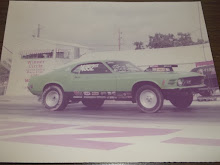65 Mustang Restoration
This weeks fun included finishing the blower motor/fan assembly for the heater box, and rebuilding the steering column.The blower assembly was pretty straight forward, add the seal between the motor & the plate, bolt it down, and install the new squirrel cage.
As I stated before,, the last motor didn't have bolts going through it that were long enough to mount the plate,, this new one that we got from NPD, was their better version (2-3 $$ more), and the bolts were perfect & when I tested it out on our car battery, it sounded & felt very good,, pretty much like you'd expect.
Now it's time to wrap it up & put it aside until it's needed.
-------------------------------------------------------------
Steering Column
On to the steering column. This is how it looked still mounted in the car (way back when).
As you can tell, a bit of cleaning is definitely in order. I cleaned the majority of the parts in the solvent tank & with old faithful, brake clean. After they were pretty clean,,, It was time for Waldo to take over and prep & paint.
And yes,, this part does come apart,, which is pretty important when installing the turn signal switch.
Back when I washed the parts all up,, that also included washing out all of the old nasty grease in the upper steering shaft support bearing,,, so now it's time to fix that. This is a handy little needle grease gun that I have,, and it worked pretty well for this task. I used one hand to hold the part and push up on the bearing from the bottom side(and slightly to one side) making a nice little gap up top in which to insert some new grease.
Then,, just try to work the grease in a bit more with your
finger until you see grease starting to ooze out from the bottom side of
the bearing,, and then wipe off the access with a rag & work in the
grease by spinning the bearing a bit.
Next, it's time to bolt the end back on with those square headed bolts,, it'll only go on one way. Notice the grease in the bearing.
Now it's time for the switch & the cone section. The wires actually go through the tube quite easily,,, HOWEVER,, you want to Carefully slide the cone section onto the tube BEFORE you slide the wires through the lower slot. You can attach the cone section with the 2 screws, but it is recommended that you make sure you are able to slide the harness all of the way through by pushing the switch temporarily into place.
You can screw the cone on in the wrong direction,, look at the turn signal lever notch area to see which way it goes back on,, and carefully screw the 2 sections back together.
Once that's complete, it's time to bolt down the switch,, it'll only go in one direction,,, But it's important to make sure that No wires are being pinched,, especially the yellow wire. Make sure you start all of the screws before you tighten them,, and double-check the wires.
And for fun, I installed the new Scott Drake Turn Signal Lever & checked out the operation of the switch.
And here's the lovely factory under the dash wiring harness,,, you always want to keep items like this if possible,, you just never know when you'll need something. I just so happen to need the 2 plastic wiring connectors.
I was planning on using the old harness so I could match up the wires by color & thickness,,, Wrong! I suppose it would have been possible if the wires hadn't faded so badly,,, luckily there's Google & I found this sweet little item.
Don't forget the install the protective sleeve onto the wires Before you install the ends. I actually slid the sleeve up inside the tube a bit to help keep the wires from chafing.
About the only other parts you'll be needing, are the shaft centering sleeve & pressure spring,, the nut that holds the steering wheel on,,
And the steering wheel. This is a new wheel, with an awesome factory horn ring that I was lucky enough to find. I found a new & rare old-school leather wrap which I hand sewed into place,, definitely gives it a much better feel & a bit more thickness for my large hands to grip onto,, very comfy!
And here it all is, completely restored & ready for install. But instead,,, I wrapped it up & put it away for now,, SOON THOUGH,, I hope!
Next,, the rear end rebuild,,,, did the 3rd member,, now it's time for the rest of it.
Till next time,,,, cya!











































































